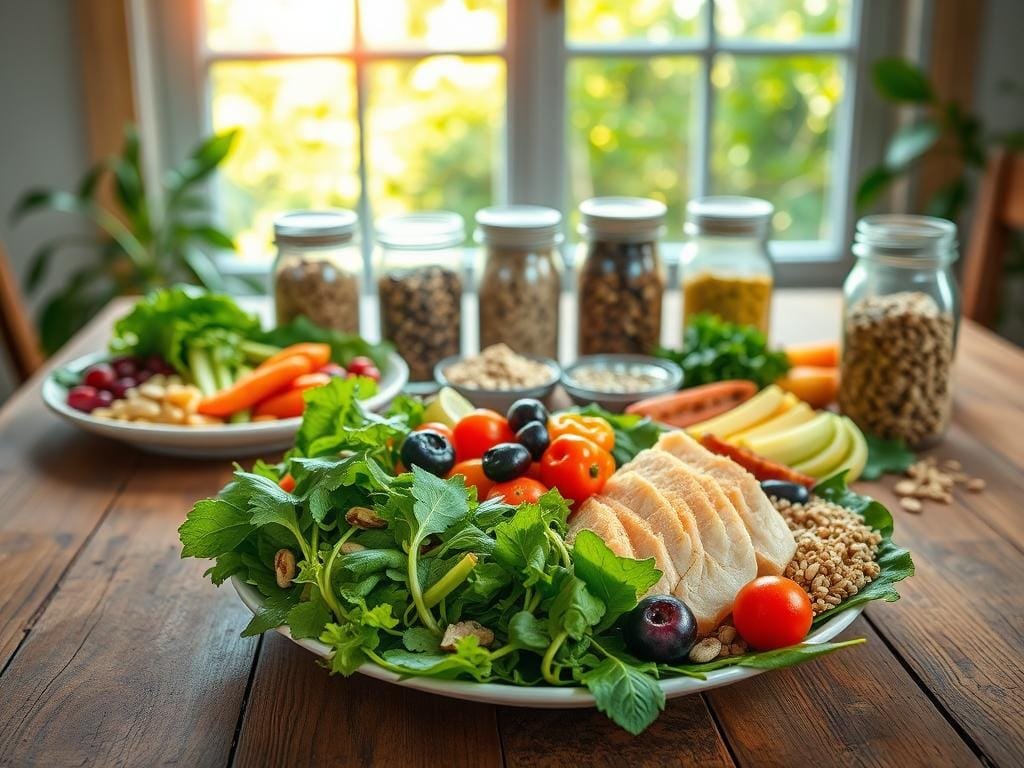Eating healthy is key to keeping you well. Did you know that up to 80% of early heart disease and stroke can be stopped? This is by making choices like adopting a healthy diet and staying active. Learning about a balanced diet is a big step towards a better life.
To begin, follow the eight tips for healthy eating. These include eating a variety of foods, cutting down on saturated fats, and drinking lots of water. Also, think about an ideal diet that has whole grains, lean proteins, and good fats. Simple changes can make a big difference in your health.
Table of Contents
Understanding the Importance of Healthy Eating
Healthy eating is more than just a diet. It’s a lifestyle that boosts your well-being. By choosing the right foods, you can greatly improve your health and lower disease risks.
Eating a balanced diet is key to staying healthy. It gives your body the nutrients it needs to work right. A well-fed body can fight off sicknesses better and heal faster.
Why Nutrition Matters for Your Health
Nutrition is essential for your health. What you eat affects your energy, brain function, and body health. Foods full of nutrients help your body work at its best.
A healthy diet can cut down your risk of heart disease and stroke. It improves your cholesterol, blood pressure, and weight. It also helps control blood sugar, which is vital for diabetes prevention and management.
| Nutrient | Benefits | Food Sources |
|---|---|---|
| Protein | Builds and repairs tissues, supports immune function | Lean meats, fish, eggs, dairy, legumes |
| Fiber | Promotes digestive health, supports healthy blood sugar levels | Fruits, vegetables, whole grains, legumes |
| Healthy Fats | Supports heart health, provides energy | Nuts, seeds, avocados, olive oil |
The Benefits of a Balanced Diet
A balanced diet has many benefits. It helps with weight management, boosts energy, and sharpens your mind. Eating a variety of foods ensures you get all the nutrients your body needs.
To start eating healthier, consider adopting habits that support a healthy lifestyle. Focus on whole foods, watch your portion sizes, and cut down on processed and sugary foods.
By understanding the importance of healthy eating and making smart choices, you can greatly improve your health and well-being.
Assessing Your Current Eating Habits
Starting a healthier eating journey means understanding your current habits. It’s key to developing healthy eating habits. This step might seem hard, but it’s essential.
To change for the better, know what and how you eat. Being mindful of your food choices is a good start. Keeping a food journal can help a lot.
Keeping a Food Journal: What to Track
A food journal is a simple yet powerful tool. It helps you track what you eat and drink over time. Here’s what to include:
- What you eat: Include all meals, snacks, and beverages.
- Portion sizes: Estimate or measure the amount of food you consume.
- Time of day: Note the time you eat to identify patterns.
- Your hunger level: Rate your hunger before and after eating.
- Your surroundings: Note where you are and what you’re doing while eating.
For more tips on improving your eating habits, check out the CDC’s page on healthy eating habits.

Identifying Areas for Improvement
After tracking your habits for a while, you can spot patterns and areas for betterment. Look for:
| Area | What to Look For |
|---|---|
| Skipping Meals | Frequent skipping of meals can lead to overeating later. |
| Emotional Eating | Eating in response to emotions instead of hunger. |
| Unhealthy Snacking | Frequent eating of high-calorie, low-nutrient snacks. |
As nutrition expert
“The way we eat is as important as what we eat.” – Marion Nestle
points out, paying attention to how we eat is just as vital as what we eat.
By understanding your habits and making small changes, you can develop healthy eating habits. Begin your journey today by being more mindful of your eating.
Setting Realistic Health Goals
Starting with realistic health goals is key to lasting change. By setting clear goals, you can create healthy eating tips that you can stick to.
SMART Goals for Eating Healthy
To really change your eating habits, set SMART goals. These should be Specific, Measurable, Achievable, Relevant, and Time-bound. For example, instead of “I want to eat healthier,” aim for “I will eat at least five servings of fruits and vegetables every day for the next three months.” This method helps you build lasting healthy eating habits.
Short-term vs Long-term Goals
It’s smart to have both short-term and long-term diet goals. Short-term goals give you quick wins, like cutting down on sugar for a month. Long-term goals focus on creating a balanced diet for years to come. For instance, a long-term goal could be to follow a Mediterranean diet full of whole grains, fruits, and healthy fats.
| Goal Type | Example | Benefit |
|---|---|---|
| Short-term | Reduce sugar intake for 30 days | Quick motivation, initial weight loss |
| Long-term | Adopt a Mediterranean diet | Sustainable health benefits, balanced nutrition |
For more tips on setting realistic health goals, check out MedStar Health’s blog on the topic. Understanding the difference between short-term wins and long-term lifestyle changes helps you make lasting progress towards a healthier life.
Building a Healthy Plate
Eating healthy starts with smart choices on your plate. A balanced meal is key for good health and getting all the nutrients you need.
To make a healthy plate, knowing portion sizes and balancing food groups is important. The Harvard Healthy Eating Plate suggests filling half with veggies and fruits. A quarter should be whole grains, and the last quarter for protein.

Understanding Portion Sizes
Knowing the right portion sizes is essential for a healthy diet. It’s easy to eat too much or too little without knowing the right amounts. Using a food scale or measuring cups can help you measure your food correctly.
Nutrients to Include in Every Meal
A balanced meal should have a variety of nutrients. Fruits and vegetables give you important vitamins and minerals. Whole grains add fiber and B vitamins. And don’t forget a source of protein like lean meats, beans, or nuts for muscle health and fullness.
By focusing on these food groups and being mindful of portion sizes, you can make meals that are both healthy and enjoyable. Healthy meal planning is about making choices that support your health and happiness.
Choosing Whole Foods Over Processed Foods
Choosing whole foods can greatly improve your health. These foods are unprocessed or lightly processed. They keep their natural nutrients and fiber. Foods like vegetables, fruits, whole grains, lean proteins, and healthy fats fall into this category.
What Are Whole Foods?
Whole foods are as natural as possible. They are full of nutrients, fiber, and antioxidants. This makes them very good for your health. Examples include:
- Fresh fruits and vegetables
- Whole grains like brown rice, quinoa, and whole-wheat bread
- Lean proteins such as chicken, fish, and legumes
- Nuts and seeds
- Healthy fats like avocado and olive oil
These foods are not only good for you but also keep you full. This helps you stay at a healthy weight. For more tips on adding whole foods to your diet, check out Healthline’s guide on eating clean.

Benefits of Minimally Processed Foods
Minimally processed foods have many health benefits. They have less added sugars, salt, and unhealthy fats than processed foods. By choosing whole foods, you can:
- Lower your risk of heart disease, diabetes, and some cancers
- Improve your digestion with more fiber
- Help manage your weight
- Get more nutrients
Adding more whole foods to your diet might seem hard at first. But, it can be done with small changes. Start by swapping processed snacks for fruits or nuts. Try to have different colors on your plate for more nutrients.
By doing this, you’ll be moving towards a balanced diet. The important thing is to make changes you can keep up with for a long time.
Meal Planning for Success
Meal planning is more than picking what to eat. It’s a way to make healthier choices for yourself. By planning your meals, you can eat a balanced diet that boosts your health.
Creating a Weekly Meal Plan
Creating a weekly meal plan involves several steps. First, figure out what you need and like to eat. Then, plan meals with whole foods like veggies, fruits, lean proteins, and grains.
- Identify your nutritional goals and dietary restrictions.
- Plan your meals for the week, considering breakfast, lunch, dinner, and snacks.
- Make a list of the ingredients you need and stick to it when you’re at the grocery store.
Planning meals helps you avoid unhealthy choices. It also cuts down on food waste and saves time.
Tips for Quick and Easy Meal Prep
Meal prep is key to a healthy diet. Here are some tips to make it fast and simple:
| Tip | Description | Benefit |
|---|---|---|
| Prepare in Advance | Chop veggies, marinate meats, and cook grains ahead of time. | Saves time during the week. |
| Use Versatile Ingredients | Choose ingredients that can be used in multiple meals. | Reduces food waste and saves money. |
| Keep it Simple | Start with simple recipes and gradually experiment with new dishes. | Makes meal prep less overwhelming. |
By using these meal planning and prep tips, you can develop lasting healthy habits. Mindful eating, like enjoying your food slowly, can also make meals more enjoyable.
Shopping for Healthy Ingredients
The journey to a balanced diet begins at the grocery store. It’s not just about picking your favorite foods. It’s about making choices that support your health.
First, know what’s in your food. Reading food labels is key for healthy eating. Look for low added sugars, saturated fats, and sodium. The American Heart Association says, “Limiting these can lower heart disease risk.”
Navigating Food Labels
Food labels can be tough to read, but knowing what to look for helps. Check the serving size and servings per container. Choose products with fewer, more familiar ingredients. Go for whole grains, lean proteins, and lots of fruits and veggies.
Creating a Grocery List that Supports Your Goals
A good grocery list is your guide to healthy eating. Plan your meals and list the ingredients you need. Focus on whole foods over processed ones. Start by shopping the store’s perimeter for fresh produce, meats, and dairy.
Think about your nutritional needs and likes when making your list. If you want less sodium, choose low-sodium canned goods. “Shopping smart means knowing the nutritional value of what you buy,” a dietitian advises.
“The key to a healthy diet is variety, so make sure to include a range of foods in your grocery list.”
By understanding food labels and planning your grocery list, you can control your diet. This will help you reach your health goals.
Staying Hydrated
Keeping your body hydrated is key for it to work well. Water is important for a healthy diet. It helps your body without adding extra calories.
Role of Water in Your Diet
Water is vital for your nutrition. It helps control body temperature, moves nutrients, and gets rid of waste. Adequate hydration keeps your energy up and supports your health.
Drinking enough water is a simple yet powerful healthy eating tip. It can greatly improve your health. Aim for six to eight glasses of water a day. But, your needs might change based on how active you are, the weather, and more.
Tips for Drinking More Water
Adding mindful eating practices can also boost your water intake. Being more aware of your body’s needs can lead to drinking more water.
- Carry a water bottle with you to encourage frequent sipping.
- Infuse your water with fruits or herbs for a refreshing taste.
- Make it a habit to drink a glass of water before each meal.
- Monitor your urine output to ensure you are drinking enough water.
By following these healthy eating tips and focusing on hydration, you can improve your health and wellbeing.
Practicing Mindful Eating
Starting your journey to healthier eating? Mindful eating can change the game. It’s about being aware of your eating habits and making choices that are good for your body.
What Is Mindful Eating?
Mindful eating means listening to your hunger and fullness signals. It’s about eating slowly and enjoying your food. You use all your senses to enjoy your meals. This way, you can have a better relationship with food and feel more satisfied.
Techniques to Eat Mindfully
To start eating mindfully, try these tips:
- Eat slowly and without distractions, such as turning off the TV or putting away your phone.
- Pay attention to the colors, smells, and textures of your food.
- Notice the flavors and temperatures of your meals.
- Listen to your body’s hunger and fullness cues to guide your eating.
For more tips on developing healthy eating habits, you can visit effective weight loss tips for lasting.
Mindful eating gets better when you know what you’re eating. Here’s a comparison of whole foods and processed foods:
| Nutritional Aspect | Whole Foods | Processed Foods |
|---|---|---|
| Vitamin Content | High in vitamins and minerals | Often stripped of vitamins and minerals |
| Preservative Content | No added preservatives | Contains added preservatives |
| Fiber Content | Rich in dietary fiber | Low in dietary fiber |
By making mindful eating a part of your daily life, you can make big changes. You’ll develop healthy eating habits that last forever.
Overcoming Challenges to Healthy Eating
Starting healthy eating habits can be tough, but you can beat common hurdles. Planning your meals and making a balanced diet are key. This helps you reach your goals.
Navigating Common Obstacles
Challenges like not having healthy food, not having time, and eating due to emotions can happen. Knowing these obstacles is the first step to beating them. For more info, check out the National Institute on Aging website.
Effective Strategies for Success
To keep up with your healthy eating goals, plan and get support from loved ones or a doctor. It’s also vital to be gentle with yourself when you slip up. For tips on starting a healthy lifestyle, including meal planning and portion control, visit Boost Healthy Life. Using these strategies daily can help you keep healthy eating habits for life.
